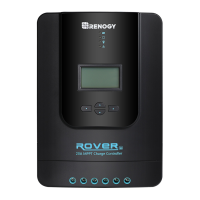05
Therefore, assuming 100% efficiency:
Power In = Power Out
Volts In * Amps In = Volts out * Amps out
Although MPPT controllers are not 100% efficient, they are very close at about 92-95% efficient.
Therefore, when the user has a solar system whose Vmp is greater than the battery bank
voltage, then that potential difference is proportional to the current boost. The voltage generated
at the solar module needs to be stepped down to a rate that could charge the battery in a stable
fashion by which the amperage is boosted accordingly to the drop. It is entirely possible to have
a solar module generate 8 amps going into the charge controller and likewise have the charge
controller send 10 amps to the battery bank. This is the essence of the MPPT charge controllers
and their advantage over traditional charge controllers. In traditional charge controllers, that
stepped down voltage amount is wasted because the controller algorithm can only dissipate it
as heat. The following demonstrates a graphical point regarding the output of MPPT technology.
Temperature is a huge enemy of solar modules. As the environmental temperature
increases, the operating voltage (Vmp
) is reduced and limits the power generation of the solar
module. Despite the effectiveness of MPPT technology, the charging algorithm will
possibly
not have much to work with and therefore there is an inevitable decrease in
performance.
In this scenario, it would be preferred to have modules with higher nominal
voltage, so that
despite the drop in performance of the panel, the battery is still receiving
a current boost
because of the proportional drop in module voltage.
Limiting Effectiveness
Maximum
Power Point
Traditional
Controller
Operating
Range
Maximum
Power Point
Current vs. Voltage (12V System) Output Power(12V System)
Typical Battery
Voltage Range
CURRENT
VOLTAGE
10 15 17
CURRENT
VOLTAGE
10 15 17

